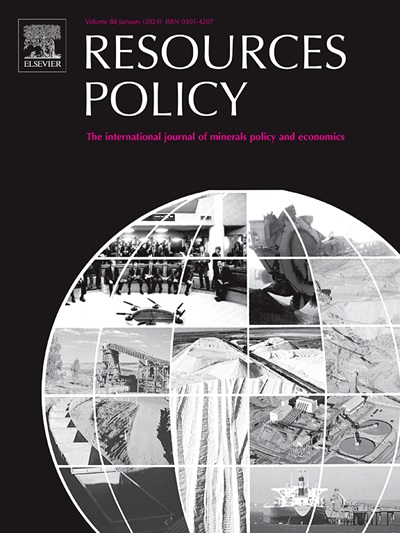"如果你不去现场,他们就会说你是懒人":妇女参与手工和小规模采矿的驱动因素:加纳北部农村地区的案例
IF 10.2
2区 经济学
0 ENVIRONMENTAL STUDIES
引用次数: 0
摘要
近年来,撒哈拉以南非洲国家妇女参与非正规手工和小规模采矿活动的人数激增。虽然许多研究将妇女更多地参与手工和小规模采矿活动归因于农村地区日益严重的经济困难,但对妇女参与手工和小规模采矿活动激增的社会经济和社会文化驱动因素的深入探讨仍然不足。本研究的问题如下:妇女更多地参与个体和小型金矿开采是与社会经济因素有关,还是与社会文化因素有关,抑或两者兼而有之?本研究采用定性案例研究设计,对加纳北部的 67 名女矿工进行了深入访谈,加纳北部是个体和小型金矿开采的新兴热点地区之一。研究通过分析 (1) 妇女参与个体和小型金矿开采的社会经济驱动因素,以及 (2) 妇女参与个体和小型金矿开采的社会文化驱动因素,回答了这一问题。这有助于确定加纳和撒哈拉以南非洲其他地区妇女参与个体和小型金矿开采的背景制约因素。研究结果表明,妇女参与个体和小型金矿开采的社会经济驱动因素是失业、家庭需求的增加、气候变化对农业的影响以及对获得实物资产的追求。这项研究的一个重要贡献是,当地社区的亚文化、社会对在个体和小型金矿开采中取得成功的妇女的认可以及婚姻方面的挑战是如何推动妇女参与个体和小型金矿开采的。如果女性矿工面临的社会文化、经济和技术障碍得到解决,参与个体和小规模采 矿从长远来看有助于增强妇女的权能。研究结果突出表明,发展中国家在将个体和小型金矿开采活动正规化的同时,迫切需要制定强有力的性别主流化政策,并创造对性别问题有敏感认识的采矿环境。本文章由计算机程序翻译,如有差异,请以英文原文为准。
“If you don't go to site, they call you a lazy person”: Drivers of women's participation in artisanal and small-scale mining: The case of rural northern Ghana
In recent years, women's involvement in informal artisanal and small-scale mining (ASM) activities in sub-Saharan African countries have surged. While many studies have attributed the increased involvement of women in ASM to the rising economic hardship in rural landscapes, a deeper interrogation of the socioeconomic and sociocultural drivers of the surge in women in ASM remains underexplored. This study inquires as follows: has women's increased participation in ASM anything to do with socioeconomic factors, or sociocultural factors, or to both? The study draws on a qualitive case study research design involving in-depth interviews with 67 women miners in northern Ghana, one of the emerging ASM hotspots. It answers the question by analyzing (1) the socioeconomic drivers of women's participation in ASM, and (2) the sociocultural drivers of women's participation in ASM. This helps in identifying the contextual constraints to women's participation in ASM in Ghana and other regions in sub-Saharan Africa. Findings show that the socioeconomic drivers of women's participation in ASM are unemployment, increasing household needs, climate change effect on agriculture, and the quest to acquire physical assets. A key contribution of the study relates to how the local communities' sub-culture, social recognition for women who made it in ASM and marital challenges drive women's participation in ASM. Participation in ASM inures to women's empowerment in the long-run provided the sociocultural, financial, and technological barriers facing women miners are addressed. The findings underscore the urgent need for a robust policy on gender mainstreaming and the creation of a gender-sensitive mining environment alongside formalization of ASM activities in developing countries.
求助全文
通过发布文献求助,成功后即可免费获取论文全文。
去求助
来源期刊

Resources Policy
ENVIRONMENTAL STUDIES-
CiteScore
13.40
自引率
23.50%
发文量
602
审稿时长
69 days
期刊介绍:
Resources Policy is an international journal focused on the economics and policy aspects of mineral and fossil fuel extraction, production, and utilization. It targets individuals in academia, government, and industry. The journal seeks original research submissions analyzing public policy, economics, social science, geography, and finance in the fields of mining, non-fuel minerals, energy minerals, fossil fuels, and metals. Mineral economics topics covered include mineral market analysis, price analysis, project evaluation, mining and sustainable development, mineral resource rents, resource curse, mineral wealth and corruption, mineral taxation and regulation, strategic minerals and their supply, and the impact of mineral development on local communities and indigenous populations. The journal specifically excludes papers with agriculture, forestry, or fisheries as their primary focus.
 求助内容:
求助内容: 应助结果提醒方式:
应助结果提醒方式:


